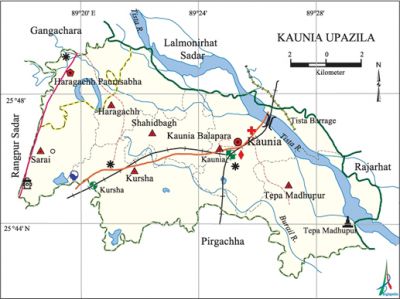Kaunia Upazila
Kaunia Upazila (rangpur district) area 147.64 sq km, located in between 25°42' and 25°50' north latitudes and in between 89°18' and 89°30' east longitudes. It is bounded by gangachara and lalmonirhat sadar upazilas on the north, pirgachha upazila on the south, Lalmonirhat Sadar and rajarhat upazilas on the east, rangpur sadar upazila on the west.
Population Total 227805; male 112701, female 115104; Muslim 212081, Hindu 15605, Christian 42 and others 77.
Water bodies Main Rivers: tista and Burail.
Administration Kaunia Thana was formed in 1916 and it was turned into an upazila in 1984.
| Upazila | ||||||||
| Municipality | Union | Mouza | Village | Population | Density (per sq km) | Literacy rate (%) | ||
| Urban | Rural | Urban | Rural | |||||
| 1 | 6 | 75 | 78 | 61425 | 166380 | 1543 | 41.4 | 42.1 |
| Municipality | ||||||||
|
Area (sq km) |
Ward |
Mahalla |
Population |
Density |
Literacy rate (%) | |||
| 16.13 | 9 | 77 | 61425 | 3808 | 41.4 | |||
| Union | ||||
| Name of union and GO code | Area (acre) | Population | Literacy rate (%) | |
| Male | Female | |||
| Kaunia Balapara 27 | 7366 | 16683 | 17005 | 46.9 |
| Tepa Madhupur 81 | 8149 | 17495 | 18138 | 38.7 |
| Shahidbagh 67 | 3208 | 9073 | 9193 | 38.8 |
| Kursha 40 | 7304 | 17259 | 17437 | 49.4 |
| Sarai 54 | 3243 | 10743 | 10693 | 41.6 |
| Haragachh 23 | 3209 | 11308 | 11353 | 31.2 |
Source Bangladesh Population Census 2011, Bangladesh Bureau of Statistics.
Archaeological heritage and relics Historic White Mosque, Bhayarhat Shiva Mandir, Zamindar Bari of Tepa, Ancient temple at Tepa Madhupur, Burir Dighi, Railway Bridge over the Tista.
War of Liberation On 1 April 1971 the freedom fighters shot and killed the Officer in Charge of the Kaunia Police Station. On 2 June the villagers killed two Pakistani soldiers attempting violation of women in a village. In retaliation the Pak army sacked the villages located on the western side of the Tista Barrage and killed nearly 200 persons on 30 June 1971.
For details: see কাউনিয়া উপজেলা, বাংলাদেশ মুক্তিযুদ্ধ জ্ঞানকোষ (Encyclopedia of Bangladesh War of Liberation), বাংলাদেশ এশিয়াটিক সোসাইটি, ঢাকা ২০২০, খণ্ড ২।

Religious institutions Mosque 239, temple 67.
Literacy rate and educational institutions Average literacy 41.9%; male 44.8%, female 39.0%. Educational institutions: college 8, technical college 3, secondary school 38, primary and satellite school 113, primary education centre 115, madrasa 16. Noted educational institutions: Kaunia Degree College (1972), Haragachh Degree College (1973), Baruarhat Technical College (2003), Gazirhat Vocational College (2001), Bailey Bridge Agricultural Diploma Institute (2003), Haragachh High School (1923), Tepa Madhupur High School (1938), Mofazzal Hossain High School (1957), Daradi High School (1962), Dhumerpara Senior Madrasa (1948), Aulia Fazil Madrasa (1957).
Newspapers and periodicals Daily: Juger Alo.
Cultural organisations Club 36, library 4, cinema hall 2.
Main sources of income Agriculture 51.08%, non-agricultural labourer 12.52%, industry 2.86%, commerce 13.18%, transport and communication 3.50%, service 5.30%, construction 1.11%, religious service 0.25%, rent and remittance 0.16% and others 10.04%.
Ownership of agricultural land Landowner 74.23%, landless 25.77%; agricultural landowner: urban 60.79% and rural 76.61%.
Main crops Paddy, wheat, tobacco, kaun, potato, vegetables.
Extinct or nearly extinct crops Jute, sesame, linseed.
Main fruits Mango, Jackfruit, banana, blackberry, guava, nut.
Communication facilities Pucca road 50 km, semi-pucca road 4 km, mud road 400 km; railway 17 km; waterway 7 km.
Extinct or nearly extinct traditional transport Palanquin, bullock cart.
Noted manufactories Rice mill, lathe machine, brick-field, leather processing factory, bidi factory, soap factory.
Cottage industries Weaving, blacksmith, potteries, bamboo work.
Hats, bazars and fairs Hats and bazars are 14, most noted of which are Sarai Hat, Shahidbagh Hat, Baroar Hat, Bhaiya Hat, Singar Kura Hat and Burir Hat, Kaunia Bazar, Haragachh Bazar and Mirbagh Bazar, Buri Mela of Shiva Mandir at Burirhat, Mela on the occasion of Austami Baruni Snan on the bank of Tista and fairs of Haragachh, Khansama, Kaunia and Tepa Madhupur on the occasion of Muharram.
Main exports Bidi, tobacco, nut, paddy, potato, wheat.
Access to electricity All the wards and unions of the upazila are under rural electrification net-work. However 63.2% of the dwelling households have access to electricity.
Mineral resources Aluminum silicate.
Sources of drinking water Tube-well 97.2%, tap 0.6% and others 2.2%.
Sanitation 47.4% of dwelling households of the upazila use sanitary latrines and 32.8% of dwelling households use non-sanitary latrines; 19.8% of households do not have latrine facilities.
Health centres Upazila health complex 2, union health and family welfare centre 6, charitable hospital 3.
NGO activities Operationally important NGOs are brac, proshika, asa, Arter Asa. [Abdus Sattar]
References Bangladesh Population Census 2001 and 2011, Bangladesh Bureau of Statistics; Cultural survey report of Kaunia Upazila 2007.
